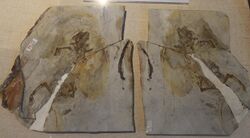Biology:Eobaataridae
| Eobaatarids | |
|---|---|

| |
| Fossil of Sinobaatar | |
| Scientific classification | |
| Domain: | Eukaryota |
| Kingdom: | Animalia |
| Phylum: | Chordata |
| Class: | Mammalia |
| Order: | †Multituberculata |
| Suborder: | †Plagiaulacida |
| Family: | †Eobaataridae Kielan-Jaworowska et al., 1987 |
| Genera | |
| |
Eobaataridae is a family of fossil mammals within the order Multituberculata. Remains are known from the Lower Cretaceous of Europe and Asia. They are among the most derived representatives of the informal suborder "Plagiaulacida", and closely related to Cimolodonta. Most eobaatarids are only known from isolated teeth, though several reasonably complete members are known, including Sinobaatar and Jeholbaatar. The body of Sinobaatar is generalised,[3] while Jeholbaatar displays clear adaptations for scansoriality (climbing) due to its elongated digits.[4] Due to the morphology of the cheek teeth, Eobaatar and Jeholbaatar are inferred to be omnivorous, likely feeding on plants and invertebrates.[4]
Indobaatar from the Early Jurassic Kota Formation has been suggested to be the earliest known multituberculate, let alone the earliest eobaatarid, and may stretch the eobaatarid-cimolodontan group much earlier than previously thought.[5] However its referral to the family has been considered questionable by other scholars.[6][7]
Fossils of Jeholbaatar kielanae seem to show that multituberculates independently acquired a middle ear from other mammal groups.[4]
Etymology
The name "Eobaatar" (from ancient Greek "ἠώς"= dawn and Mongolian "baatar"= hero) means "dawn hero".
Notes
- ↑ Nao Kusuhashi; Yaoming Hu; Yuanqing Wang; Takeshi Setoguchi; Hiroshige Marsuoka (2010). "New multituberculate mammals from the Lower Cretaceous (Shahai and Fuxin formations), northeastern China". Journal of Vertebrate Paleontology 30 (5): 1501–1514. doi:10.1080/02724634.2010.501435.
- ↑ 2.0 2.1 Nao Kusuhashi (2008). "Early Cretaceous multituberculate mammals from the Kuwajima Formation (Tetori Group), central Japan". Acta Palaeontologica Polonica 53 (3): 379–390. doi:10.4202/app.2008.0302.
- ↑ Hu, Yaoming (2002). "Sinobaatar gen. nov.: First multituberculate from the Jehol Biota of Liaoning, Northeast China" (in en). Chinese Science Bulletin 47 (11): 933. doi:10.1360/02tb9209. ISSN 1001-6538. http://www.scichina.com/ky/0211/ky0933.stm.
- ↑ 4.0 4.1 4.2 Haibing Wang; Jin Meng; Yuanqing Wang (2019). "Cretaceous fossil reveals a new pattern in mammalian middle ear evolution". Nature 576 (7785): 102–105. doi:10.1038/s41586-019-1792-0. PMID 31776514.
- ↑ Parmar, Prasad, and Kumar (2013) The first multituberculate mammal from India. Naturwissenschaften
- ↑ Kusuhashi, Nao; Wang, Yuan-Qing; Jin, Xun (2019-08-23). "A New Eobaatarid Multituberculate (Mammalia) from the Lower Cretaceous Fuxin Formation, Fuxin-Jinzhou Basin, Liaoning, Northeastern China" (in en). Journal of Mammalian Evolution 27 (4): 605–623. doi:10.1007/s10914-019-09481-w. ISSN 1064-7554. http://link.springer.com/10.1007/s10914-019-09481-w.
- ↑ Averianov, Alexander; Lopatin, Alexey; Skutschas, Pavel; Ivantsov, Stepan; Boitsova, Elizaveta; Kuzmin, Ivan (2017). "An enigmatic multituberculate mammal from the Early Cretaceous of Siberia, Russia". Journal of Vertebrate Paleontology 37 (2): e1293070. doi:10.1080/02724634.2017.1293070. http://www.tandfonline.com/doi/abs/10.1080/02724634.2017.1293070.
References
- Kielan-Jaworowska, Dashzeveg & Trofimov (1987), "Early Cretaceous multituberculates from Mongolia and a comparison with Late Jurassic forms". Acta Palaeontologica Polonica 32, p. 3-47.
- Kielan-Jaworowska, Z.; Hurum, J.H. (2001). "Phylogeny and Systematics of multituberculate mammals". Palaeontology 44 (3): 389–429. doi:10.1111/1475-4983.00185.
External links
- Most of this information has been derived from MESOZOIC MAMMALS: Plagiaulacidae, Albionbaataridae, Eobaataridae & Arginbaataridae
Wikidata ☰ Q2005380 entry
 |

